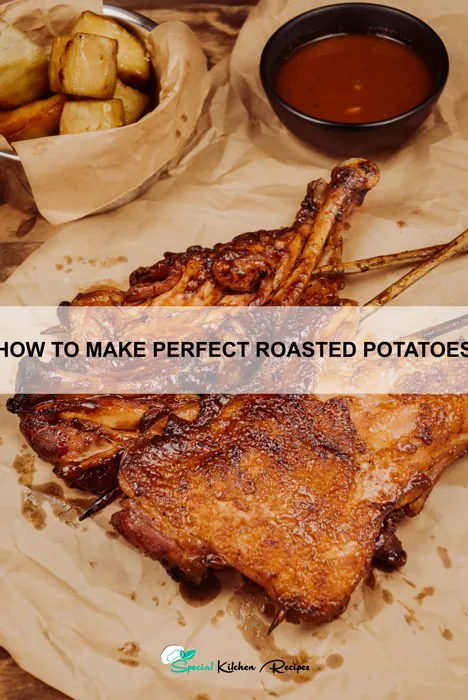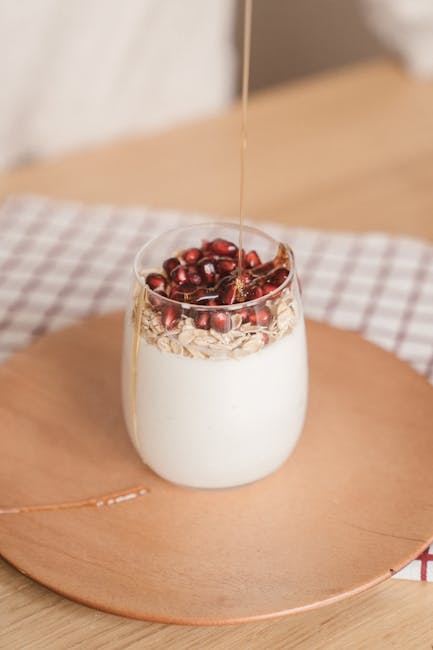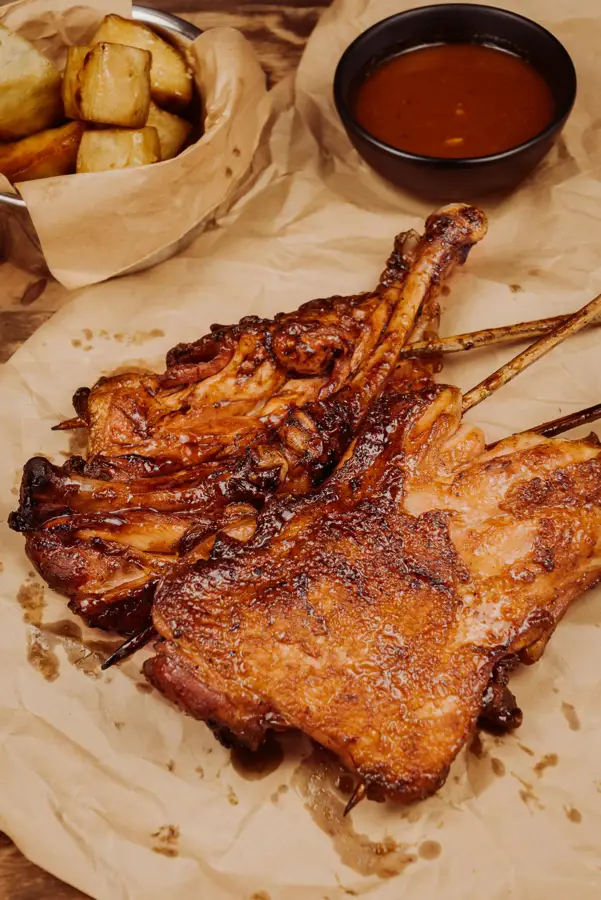The humble roasted potato: a dish so simple, yet capable of delivering such intense flavor and satisfying texture. While pinpointing the exact origin is difficult, the practice of roasting root vegetables, including potatoes, dates back centuries. Evidence suggests that various cultures, from ancient civilizations in the Andes (where the potato originated) to early European settlers, developed their own methods of preparing potatoes in the earth’s embrace. The potato itself, Solanum tuberosum, wasn’t widely adopted in Europe until the 16th century after its introduction from the Americas, initially met with suspicion and even fear. However, its nutritional value and versatility quickly won over populations, leading to its integration into countless cuisines.
Over time, roasting potatoes evolved from a simple method of cooking a readily available food source to a culinary art form. The development of ovens and various cooking techniques allowed for greater control over the cooking process, leading to the crispy, golden-brown perfection we associate with roasted potatoes today. Interestingly, the global potato production is staggering, with an estimated 370 million tonnes produced annually, showcasing its enduring popularity. This vast production contributes significantly to food security and economies worldwide, highlighting the potato’s importance beyond its deliciousness.
Roasted potatoes hold significant cultural importance in numerous traditions. From the classic Sunday roast in Britain, where perfectly roasted potatoes are a centerpiece, to the hearty potato dishes found throughout Europe and beyond, this seemingly simple side dish represents comfort, tradition, and shared meals. In some cultures, specific potato varieties are favored for roasting, reflecting regional preferences and historical practices. For instance, certain waxy potatoes are preferred for their ability to retain moisture during roasting, while others, like russets, are favored for their fluffy interior and crispy exterior. The variations in preparation, from herbs and spices used to the cutting style employed, showcase the remarkable adaptability and cultural significance of this beloved dish.
Ingredients and Measurements
The key to perfectly roasted potatoes lies not only in the technique but also in the careful selection and measurement of your ingredients. Using the right type of potato is crucial, as is paying attention to the quantity of oil and seasoning.
For this recipe, we’ll be using 2 pounds (approximately 900g) of Yukon Gold potatoes. Yukon Golds offer a fantastic balance of fluffy interior and crispy exterior, making them ideal for roasting. However, you can substitute with other waxy potatoes like red potatoes or fingerlings, just be aware that the cooking time might need slight adjustment.
Oil is essential for achieving that coveted crispy skin. We recommend using ¼ cup (60ml) of high-heat oil, such as avocado, grapeseed, or canola oil. Olive oil can be used, but its lower smoke point might lead to burning at higher temperatures. Don’t skimp on the oil; it’s crucial for even browning and preventing the potatoes from sticking to the pan.
Seasoning is where you can get creative! We’ll start with the basics: 1 teaspoon of sea salt and ½ teaspoon of freshly ground black pepper. These provide a solid foundation of flavor. Feel free to experiment further! Consider adding:
- 1 teaspoon of garlic powder for a savory kick
- ½ teaspoon of onion powder for added depth
- ½ teaspoon of paprika for a smoky touch
- ¼ teaspoon of cayenne pepper for a hint of spice (optional)
- 2 tablespoons of fresh herbs, such as rosemary or thyme, roughly chopped, for aromatic complexity.
Remember to adjust seasoning to your taste. Start with the suggested amounts and add more as needed. Taste the potatoes as they roast and season accordingly. Don’t be afraid to experiment with different herb and spice combinations to find your perfect blend.
Finally, consider adding other ingredients for extra flavor. A tablespoon or two of freshly squeezed lemon juice added at the end can brighten the finished dish, while a sprinkle of dried herbs just before serving adds visual appeal and further enhances the aroma.
Precise measurements are key to achieving consistent results. Using a kitchen scale for weighing the potatoes and measuring cups and spoons for the oil and seasonings will ensure your potatoes roast perfectly every time.
Equipment List
Creating perfectly roasted potatoes requires the right tools. While you might be able to improvise, having the correct equipment will significantly enhance the outcome, ensuring crispy exteriors and fluffy interiors.
The most crucial piece of equipment is a large roasting pan. Aim for a size that comfortably holds your potatoes in a single layer, allowing for even air circulation. A 15×10 inch roasting pan is ideal for approximately 2 pounds of potatoes, but adjust the size based on your recipe. Avoid overcrowding; this will steam the potatoes instead of roasting them.
A good quality chef’s knife is essential for prepping the potatoes. A sharp knife ensures clean, even cuts, which contribute to consistent cooking. A dull knife will crush and bruise the potatoes, leading to uneven browning and mushy texture. Aim for a knife with a blade length of at least 8 inches for efficient chopping and paring.
Measuring tools are vital for accuracy. You’ll need measuring spoons (1 teaspoon, 1 tablespoon) and a measuring cup (at least 2 cups capacity) to accurately measure your oil, herbs, and spices. Inconsistent measurements can lead to inconsistent flavor and texture.
For even cooking and browning, a large bowl is necessary for tossing the potatoes. A wide, shallow bowl is preferable to a deep one, which makes tossing the potatoes easier and ensures complete coating with oil and seasoning. A 5-quart bowl is generally sufficient, but again, adjust based on your quantity of potatoes.
Optional, but highly recommended, is a wire rack for your roasting pan. Placing the potatoes on a wire rack elevates them, allowing for more even heat circulation and crispier results. The rack prevents the potatoes from sitting in their own rendered fat, which can lead to sogginess.
Finally, kitchen tongs are invaluable for turning the potatoes. Using tongs allows you to gently maneuver the potatoes without piercing them or damaging their skins, preserving their integrity and ensuring even browning. Avoid using forks, as this can release steam and reduce crispness.
In summary: A large roasting pan, a sharp chef’s knife, measuring spoons and cups, a large bowl, and kitchen tongs are essential. A wire rack is highly recommended for superior results. Investing in good quality equipment will significantly improve your roasting potato experience and yield consistently delicious results.
Potato Preparation (Washing, Peeling, Cutting)
The key to perfectly roasted potatoes begins with proper preparation. We’ll be using 2 pounds (approximately 900 grams) of potatoes for this recipe, but you can easily adjust the quantities to suit your needs. Choose potatoes that are firm to the touch and free from blemishes. Avoid potatoes that are sprouting or feel soft, as these indicate age and may result in a less-than-ideal texture.
First, thoroughly wash the potatoes under cold running water. Use a vegetable brush to scrub away any clinging dirt or soil. Thorough washing is crucial to remove any pesticides or soil that might impart an unpleasant flavor to your finished potatoes.
Next, decide whether you’ll peel your potatoes or leave the skins on. For a rustic look and added nutrients, leaving the skins on is perfectly acceptable, provided you’ve thoroughly cleaned them. If you choose to peel them, use a vegetable peeler to remove the skin efficiently. Be careful not to remove too much potato flesh during peeling, as this will reduce the yield.
Now comes the cutting. The size and shape of your potato pieces will directly impact their roasting time and texture. For evenly roasted potatoes, aim for consistently sized pieces. Uniform size ensures even cooking; larger pieces will take longer to cook than smaller ones, leading to uneven browning and potential sogginess. We recommend cutting the potatoes into 1-inch (2.5cm) cubes or wedges. If using smaller potatoes, you can halve or quarter them instead.
Once cut, rinse the potatoes again under cold water to remove any excess starch. This step helps to prevent sticking and promotes crispier results. Removing excess starch is a crucial step often overlooked, but it makes a significant difference in the final texture. Drain the potatoes well in a colander before proceeding to the next step of the recipe – tossing them with oil and seasonings.
Finally, consider the type of potato you are using. Russet potatoes, with their high starch content, are ideal for roasting as they create a fluffy interior and crispy exterior. Yukon golds also work well, although they tend to be slightly less fluffy. Choosing the right potato variety is essential for achieving the desired texture and flavor.
Seasoning and Flavoring
Seasoning your potatoes correctly is crucial for achieving perfectly roasted spuds. Don’t be shy with the salt – it’s the foundation of good flavor. A generous 1 teaspoon of kosher salt per pound of potatoes is a great starting point. Fine sea salt can be used, but reduce the amount by about half as it’s more concentrated. Remember, you can always add more, but you can’t take it away!
Freshly ground black pepper is another essential. Start with ½ teaspoon per pound of potatoes and adjust to your taste. Coarsely ground pepper adds a delightful textural element, complementing the crispy exterior of the potatoes. Consider adding a pinch of cayenne pepper or paprika for a subtle kick, especially if you’re using milder potatoes.
Beyond the basics, the possibilities are endless! Experiment with different herbs and spices to create unique flavor profiles. Rosemary and thyme are classic pairings, offering robust, earthy notes that complement the potatoes beautifully. Use about 1-2 tablespoons of fresh, chopped herbs per pound of potatoes, or 1 teaspoon of dried herbs.
Garlic is another fantastic addition. Minced garlic cloves, added directly to the potatoes before roasting, infuse a wonderful savory aroma. Start with 2-3 cloves per pound of potatoes, or more to your liking. Garlic powder can be substituted, but fresh garlic offers a more vibrant flavor.
For extra depth of flavor, consider incorporating other aromatics. A drizzle of olive oil (about 2 tablespoons per pound of potatoes) not only helps create a crispy exterior but also carries the flavor of your chosen herbs and spices. Don’t be afraid to experiment with different oils – a touch of truffle oil, for example, can elevate your roasted potatoes to a gourmet level.
Finally, remember to toss the potatoes well with the seasoning and oil to ensure even coating. This guarantees that every potato receives the same delicious treatment. Don’t skimp on this step – it’s key to achieving perfectly seasoned and flavorful roasted potatoes.
Roasting Process (Oven Temperature, Cooking Time, Basting)
The key to perfectly roasted potatoes lies in achieving a crisp exterior and a fluffy interior. This is accomplished through careful control of oven temperature, cooking time, and basting. Preheat your oven to 400°F (200°C). This high temperature is crucial for developing that desirable crispy skin. Lower temperatures will result in soggy potatoes.
Cooking time depends heavily on the size and type of potato. For small, uniformly sized potatoes (like Yukon Golds or red potatoes, about 1-1.5 inches in diameter), 30-40 minutes is usually sufficient. Larger potatoes (like russets, about 2 inches or more in diameter) will require 45-60 minutes, or even longer. The best way to check for doneness is to pierce a potato with a fork; it should offer little resistance when easily pierced.
Don’t overcrowd the baking sheet. Overcrowding prevents proper air circulation, leading to uneven cooking and steaming rather than roasting. Arrange the potatoes in a single layer, ensuring they’re not touching each other as much as possible. If necessary, use two baking sheets.
Basting is optional but highly recommended for extra flavor and crispness. Basting involves spooning melted fat (such as rendered bacon fat, olive oil, or duck fat) over the potatoes halfway through the cooking process. This adds flavor and helps to crisp the skin. You can baste again during the last 10-15 minutes of cooking if desired. For best results, use a high-smoke point oil like avocado oil or grapeseed oil.
For extra crispy potatoes, consider tossing them halfway through cooking. This ensures even browning on all sides. You can also add fresh herbs (rosemary, thyme) or spices (garlic powder, paprika) during the basting process for enhanced flavor. Remember to adjust cooking time based on the size of your potatoes and your oven. Always check for doneness before removing them from the oven.
Important Note: Oven temperatures can vary, so keep an eye on your potatoes and adjust the cooking time as needed. Slightly undercooked potatoes can be returned to the oven for a few more minutes, but overcooked potatoes are difficult to salvage.
Checking for Doneness
Achieving perfectly roasted potatoes requires careful attention to doneness. Overcooked potatoes become mushy and lose their texture, while undercooked potatoes remain hard and unappetizing. The ideal roast boasts a crispy exterior and a fluffy, tender interior. There are several ways to check for doneness, and employing a combination of methods is often best.
The visual test is your first line of defense. Look for deeply golden-brown, even browning across the majority of the potato surfaces. Deeply browned edges indicate excellent caramelization and crispness. However, visual cues alone are not sufficient; some potatoes may brown quickly on the outside while remaining undercooked inside.
The pierce test is a reliable method. Using a fork or a thin skewer, gently pierce the thickest part of several potatoes. If the fork goes in easily, with minimal resistance, and the potato offers slight give, they are likely done. Don’t over-pierce; excessive piercing will release moisture and reduce crispiness. If the fork meets significant resistance, the potatoes need more time in the oven.
The internal temperature test provides the most accurate assessment of doneness. Use an instant-read thermometer to check the internal temperature of the thickest part of several potatoes. The ideal internal temperature for perfectly roasted potatoes is between 205°F (96°C) and 210°F (99°C). Temperatures below this range indicate undercooked potatoes, while temperatures significantly above this range suggest overcooked potatoes.
Consider the potato variety when checking for doneness. Starchy potatoes, like russets, tend to cook faster and become fluffier than waxy potatoes, like red potatoes, which hold their shape better. Waxy potatoes may require a slightly longer cooking time to achieve the same level of tenderness.
Timing is crucial. While recipes provide estimated cooking times, oven temperatures can vary, and potato size impacts cooking time. Always start checking for doneness 10-15 minutes before the estimated end time. This allows for adjustments if needed, preventing overcooking. Remember that potatoes continue to cook slightly even after being removed from the oven due to residual heat. Allowing them to rest for 5-10 minutes before serving helps achieve optimal texture and moisture distribution.
By employing a combination of visual inspection, the pierce test, and the internal temperature test, you can consistently achieve perfectly roasted potatoes every time. Don’t be afraid to experiment and adjust your cooking time based on your oven and the specific type of potatoes you are using.
Recommendations
For perfectly roasted potatoes, achieving that crispy exterior and fluffy interior is key. Start with the right potatoes; russets, Yukon golds, or red potatoes all work well, but choose firm, similar-sized potatoes for even cooking. Don’t overcrowd the pan; potatoes need space to brown properly. Consider parboiling for extra fluffy insides, but ensure you dry them thoroughly before roasting to encourage crispiness. Experiment with different seasonings; rosemary, thyme, garlic powder, and paprika are classic choices, but don’t be afraid to get creative!
Serving suggestions are endless! Roasted potatoes are a fantastic side dish for almost any main course. They pair beautifully with roast chicken or beef, grilled salmon, or even vegetarian dishes like lentil stew. Consider adding fresh herbs like parsley or chives right before serving for extra flavor and visual appeal. For a truly decadent meal, try tossing them with a little melted butter or a flavorful vinaigrette after roasting.
Storage: Leftover roasted potatoes can be stored in an airtight container in the refrigerator for up to 3-4 days. Reheat them gently in a pan or oven to avoid drying them out. They can also be frozen for longer storage; allow them to cool completely before freezing to prevent ice crystal formation.
Nutritional Information (per 100g, approximate values, may vary based on potato type and added ingredients): Calories: 100-150, Fat: 3-5g, Carbohydrates: 20-25g, Protein: 2-3g, Fiber: 2-3g. These values are estimates and will change depending on the added fats and seasonings used in your recipe. Note: Nutritional information is significantly altered by the addition of oils, butter, and seasonings.
Complementary Dishes: Roasted potatoes are incredibly versatile. They complement a wide range of flavors and cuisines. Consider serving them alongside dishes featuring contrasting textures and flavors. For instance, a creamy sauce or a bright, acidic salad would create a delicious balance. They also make a wonderful addition to hearty stews or soups, adding a satisfying textural contrast.
Important Note: Always ensure potatoes are cooked thoroughly to avoid foodborne illness. Internal temperature should reach at least 160°F (71°C).





